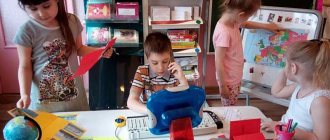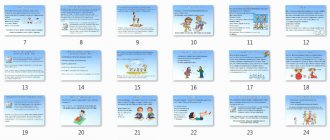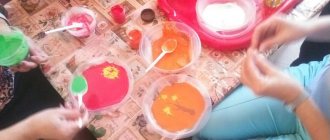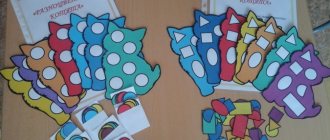Gaming technologies for preschoolers
The age of children in which the foundations of personality are laid, will is developed, and social competence is formed is called preschool. It is unique and decisive at the beginning of a child’s developmental stage. Game-based learning should be interesting, entertaining, but not entertaining.
Game pedagogical technology is the organization of the pedagogical process in the form of various pedagogical games . This concept differs from games in that they have a clearly defined goal and a corresponding pedagogical result. Game-based pedagogical technology includes various methods and techniques for organizing the pedagogical process in the form of games. The result of the games is justified, observed explicitly and characterized by a certain educational focus.
The goal of gaming technology is to create a full-fledged motivational basis for the formation of skills and abilities of activity, depending on the operating conditions of the preschool institution and the level of development of children.
Games are mainly children’s own initiative, therefore, when organizing gaming activities, the teacher must be guided by the following requirements:
- game selection. Should act as a means of satisfying the interests and needs of children. Typically, the choice of game depends on educational tasks that require their logical solution. That is, children show interest in the game, actively act and get a result veiled by the game task - there is a natural substitution of motives from educational to gaming;
- game proposal. A gaming problem is created. To solve it, children are offered various game tasks, such as action techniques and rules;
- explanation of the game. The teacher briefly and clearly explains the rules and techniques of the game, but only after the children’s interest in the game arises;
- gaming equipment. It must comply as much as possible with the content of the game and all the requirements for the subject-game environment according to the Federal State Educational Standard;
— organization of a gaming group. Game tasks are formulated in such a way that each child can demonstrate their activity and organizational skills. Children can act depending on the progress of the game individually, in pairs or teams, collectively;
- development of the game situation. It is characterized by the following principles: the absence of coercion of any form when involving children in the game; the presence of game dynamics; maintaining a gaming atmosphere; the relationship between gaming and non-gaming activities;
- end of the game. The result of children's gaming activities should be analyzed and aimed at application in real life.
Based on the nature of the pedagogical process, the following groups of games are distinguished:
— teaching, training, controlling, generalizing;
- cognitive, educational, developmental;
- reproductive, productive, creative, communicative, diagnostic, career guidance, psychotechnical and others.
Types of pedagogical games can be very diverse . They are divided:
- By type of activity - motor, intellectual, psychological, etc.
- By the nature of the pedagogical process - teaching, training, controlling, cognitive, educational, developmental, diagnostic.
- The nature of the gaming methodology is games with rules; games with rules established during the game; a game where one part of the rules is specified by the conditions of the game, and is established depending on its progress.
- In terms of content - musical, mathematical, socializing, logical, etc.
- By gaming equipment - tabletop, computer, theatrical, role-playing, director's, etc.
The gaming technology component is the direct interaction and communication between the teacher and children, which is immediate and systematic. Game Technology Component:
— activates students;
- increases cognitive interest;
- causes emotional uplift;
- promotes the creative development of the child;
— concentrates class time as much as possible due to clearly formulated game conditions;
— allows the teacher to change the strategy and tactics of game actions by complicating or simplifying game tasks, depending on the level of mastery of the material.
Gaming technology is organized as a holistic education, which covers some part of the educational process, and also unites it with common content, plot, and character. It includes sequentially:
- games and exercises that develop the ability to identify the main, characteristic features of objects, compare and contrast them;
- groups of games to generalize objects according to certain characteristics;
- groups of games, during which preschoolers develop the ability to distinguish real from unreal phenomena;
- groups of games that develop the ability to control oneself, speed of reaction to a word, phonemic awareness, ingenuity, etc.
The task of each teacher is to compile gaming technologies from individual games and elements. In the last decade, in connection with the development of the world community, the human personality has become a priority at the center of the education and upbringing system. The main component of the formation of the human personality is the teacher, who is at the same time the bearer of universal human values and the creator of a creative personality. Constant fluctuations and changes in society determine the difficulty for the teacher and confront him with the need for value self-determination, requiring him to implement democratic and humanistic principles in pedagogical activity. In other words, the basis of a teacher’s activity is the definition and use of his personal creative potential, which is the system-forming factor of the author’s pedagogical system, the ascent from individual pedagogical functions (actions, situations) to their system, from standard technologies to creative, personality-oriented ones, which are based on there should be a dialogical approach, pedagogical training, role-playing games, analysis of the pedagogical situation, creation of a “situation of success”, co-creation in conducting and preparing creative comprehensive educational activities.
If a teacher uses the latest pedagogical technologies, what qualities should he have? Today, the priority and sought-after qualities of a teacher are such personal qualities (image) as the art of communication, openness, sincerity, goodwill, erudition, outlook, artistry, charm, empathy, improvisation, imagination, reflection, the ability to detect “new formations” and changes in time. in the relationships of children, their moods, reactions. Thus, gaming technologies help children to relax and show self-confidence, while facilitating easy learning of material of any complexity, by bringing the gaming situation closer to real life conditions.
Literature:
- Kasatkina E.I. Game in the life of a preschooler. - M., 2010.
- Kasatkina E.I. Game technologies in the educational process of preschool educational institutions. //Management of preschool educational institution. - 2012. - No. 5.
STEM technology is a new stage in preschool education
STEM technology is a new stage in preschool education
Currently, one of the most pressing problems of modern education is achieving modern quality of education. A modern teacher is, first of all, an erudite, energetic, creative person who has professional qualities and loves his job. Every day new types of work and even entire professional areas appear, which is why modern teachers must think about whether the knowledge and skills they teach meet the needs of the time? What might interest our students, you ask?.. Of course, STEM technology. It is STEM technology that will allow teachers to raise a generation of successful researchers, inventors, technologists and mathematicians.
A distinctive feature of this pedagogical system is that STEM technology can be successfully used within the framework of the main educational program of preschool education, and each of its educational modules can be independently used in various forms of the educational process.
The purpose of using
STEM technology
in a preschool educational institution is to develop the intellectual abilities of preschool children.
What is STEM? If you decipher it, you get the following: S - science, T - technology, E - engineering, M -mathematics (natural sciences, technology, engineering, mathematics). STEM technology must be used already in working with preschool children, since our preschoolers must be ready for school innovations, creating projects and the ability to implement them in reality .
Today you can find a wide variety of educational modules that are included in STEM technology:
LEGO construction
.
This module in a playful way allows you to introduce the basic principles of mechanics and the operating features of the simplest mechanisms.
Mathematical development
It includes board educational games, manuals for sensory development, sets of geometric solids and figures, demonstration and handout materials in the areas of mathematical development, logic puzzles, sorters, inset frames and volumetric inserts, abaci, abacus, mathematical constructors, lacing, Lull circles and etc.
Experimenting with living and inanimate nature
This module allows children to become familiar with the properties of water, air, objects of inanimate and living nature, and optical phenomena in the process of research activities.
Didactic system of F. Froebel
;
This module is aimed at forming a natural-scientific picture of the world and developing spatial thinking in preschool and younger children
Multistudio “I create the world”
An essential part of STEM education is introducing children to digital technologies. The module “Multi-studio “I create the world”” will help with this. It allows you to summarize and demonstrate at a modern level the results of children’s work on various projects through the child’s creation of his own animated film
Robotics
The Robotics module includes several construction kits. Construction kits from the educational module “Robotics” promote the development of design skills.
In September 2022, we began introducing STEM technology.
In our preschool educational institution, we use STEM technology both in educational activities and in play activities. The use of STEM technology in gameplay helps teach children to analyze everything that happens around them, to see phenomena and systems not only in structure, but also in time dynamics. Having become acquainted with the innovative technologies that are used in preschool education, we came to the conclusion that the use of STEM technology will allow us to achieve the highest results in the cognitive development of children, because STEM technology is aimed at developing the thinking, imagination, and intellectual abilities of preschool children. For this academic year we have identified 2 educational modules for ourselves. The first module is LEGO construction. Second module – Mathematical development .
The teachers produced teaching aids for games and Lull rings. We established close contacts with colleagues from the Center for Additional Education for Children who have experience in using LEGO construction. So far, two groups of preschool age from 3 to 7 years are involved in the implementation of STEM technology, which is 38% of the total number of preschool children.
Our preschool educational institution has created pedagogical conditions for working with children. The work is structured in accordance with the requirements of the Basic Educational Program, developed on the basis of the Federal State Educational Standard for Education and in combination with a set of methodological literature “STEM education of children of preschool and primary school age” edited by V.A. Markova and others.
It should be noted that STEAM competencies can be developed in children from a very early age, using games that parents can easily organize at home. Crafts made from salt dough are toys, creating which the baby encounters three dimensions for the first time: height, width and length. Modeling from plasticine will demonstrate how art combines with modeling. A construction set made of cardboard will help your child learn to recognize various sensory standards, and also to design. Children like LEGO because they can create completely different designs from the same elements.






